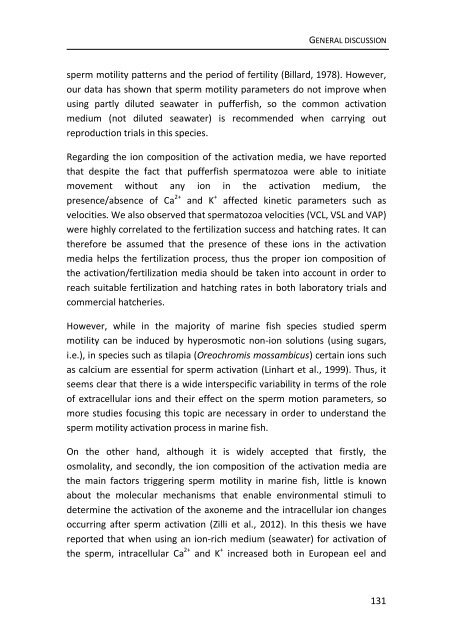chapter 3 - RiuNet
chapter 3 - RiuNet
chapter 3 - RiuNet
Create successful ePaper yourself
Turn your PDF publications into a flip-book with our unique Google optimized e-Paper software.
GENERAL DISCUSSION<br />
sperm motility patterns and the period of fertility (Billard, 1978). However,<br />
our data has shown that sperm motility parameters do not improve when<br />
using partly diluted seawater in pufferfish, so the common activation<br />
medium (not diluted seawater) is recommended when carrying out<br />
reproduction trials in this species.<br />
Regarding the ion composition of the activation media, we have reported<br />
that despite the fact that pufferfish spermatozoa were able to initiate<br />
movement without any ion in the activation medium, the<br />
presence/absence of Ca 2+ and K + affected kinetic parameters such as<br />
velocities. We also observed that spermatozoa velocities (VCL, VSL and VAP)<br />
were highly correlated to the fertilization success and hatching rates. It can<br />
therefore be assumed that the presence of these ions in the activation<br />
media helps the fertilization process, thus the proper ion composition of<br />
the activation/fertilization media should be taken into account in order to<br />
reach suitable fertilization and hatching rates in both laboratory trials and<br />
commercial hatcheries.<br />
However, while in the majority of marine fish species studied sperm<br />
motility can be induced by hyperosmotic non-ion solutions (using sugars,<br />
i.e.), in species such as tilapia (Oreochromis mossambicus) certain ions such<br />
as calcium are essential for sperm activation (Linhart et al., 1999). Thus, it<br />
seems clear that there is a wide interspecific variability in terms of the role<br />
of extracellular ions and their effect on the sperm motion parameters, so<br />
more studies focusing this topic are necessary in order to understand the<br />
sperm motility activation process in marine fish.<br />
On the other hand, although it is widely accepted that firstly, the<br />
osmolality, and secondly, the ion composition of the activation media are<br />
the main factors triggering sperm motility in marine fish, little is known<br />
about the molecular mechanisms that enable environmental stimuli to<br />
determine the activation of the axoneme and the intracellular ion changes<br />
occurring after sperm activation (Zilli et al., 2012). In this thesis we have<br />
reported that when using an ion-rich medium (seawater) for activation of<br />
the sperm, intracellular Ca 2+ and K + increased both in European eel and<br />
131
















